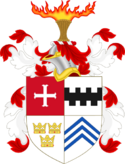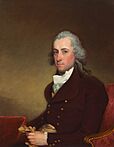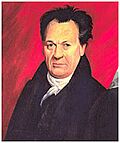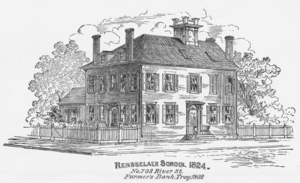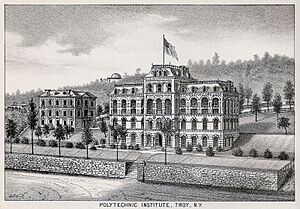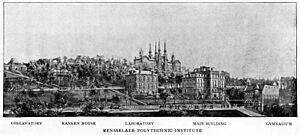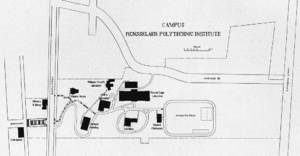History of Rensselaer Polytechnic Institute facts for kids
The history of Rensselaer Polytechnic Institute (RPI) began in 1824. RPI is the oldest technology university that has been open continuously in both the English-speaking world and the Americas. It was the first school in the United States to give out a degree in civil engineering in 1835. Later, in 1961, RPI also offered the first degree in environmental engineering in the U.S. And in 2007, it might have been the first to offer a bachelor's degree in video game design.
Contents
Key Moments in RPI's History
| 1824 | The Rensselaer School is started. |
| 1825 | The school opens on January 5. |
| 1826 | The State of New York officially recognizes the school. |
| 1834 | The school is renamed the Rensselaer Institute. |
| 1835 | The Institute gives out the first civil engineering degree in the U.S. |
| 1861 | The school is renamed the Rensselaer Polytechnic Institute. |
| 1864 | The Great Troy Fire destroys the school's building. |
| 1873 | RPI plays its first college sports game (baseball) against Union College. |
| 1881 | Garnet Baltimore, the first African-American student, earns a degree from Rensselaer. |
| 1904 | Fire destroys the Main Building. |
| 1914 | RPI gives out its first master's degree in mechanical engineering. |
| 1945 | Lois Graham and Mary Ellen Rathbun become the first two women to earn degrees from the institute. |
| 1961 | RPI gives out the first environmental engineering degree in the U.S. |
| 1973 | Ivar Giaever becomes the first RPI graduate to win the Nobel Prize in Physics. |
| 1999 | Shirley Ann Jackson is chosen as the first African-American female university president in the U.S. |
| 2000 | The Rensselaer Plan, a big vision for the future, is announced. |
Before RPI: The van Rensselaer Family
In 1609, Henry Hudson explored for Holland and sailed up what is now the Hudson River. This led to the Dutch setting up fur trading posts in an area they called "New Netherland." In 1630, Kiliaen van Rensselaer became the owner of Rensselaerswyck. This was a huge piece of land, 24 miles long and 48 miles wide. It covered parts of what are now Albany, Rensselaer, and Columbia counties.
Later, in 1789, people living in the area met and decided to name their village Troy.
How RPI Was Started
Stephen van Rensselaer III started the Rensselaer School on November 5, 1824. He wrote a letter to Rev. Dr. Samuel Blatchford, asking him to be the first president. In the letter, Van Rensselaer also named Amos Eaton as the school's first senior professor. He also chose the first group of trustees to guide the school.
Some people used to believe that Van Rensselaer and Eaton met in prison. While Amos Eaton had been in prison from 1810 to 1815, he and Stephen van Rensselaer actually met in 1820. Van Rensselaer hired Eaton to survey the land for what would become the Erie Canal. Van Rensselaer even let Eaton give lectures in towns along the way. This was a clear sign of what was to come with the founding of a new school.
The main goal of the institute was to teach students how to use science and technology in everyday life. On December 29, 1824, the president and trustees met. They decided on teaching methods that were very different from other colleges at the time. Students spent six hours a day doing experiments and explaining their ideas. They even gave their own lectures instead of just listening to professors.
This unusual way of teaching was meant to train students to become teachers themselves. Van Rensselaer wanted graduates to be able to teach farmers' and mechanics' children. They would learn about chemistry, science, and nature. This knowledge would help them in farming, running their homes, and making things. Van Rensselaer even offered to pay for students' tuition if they promised to teach locally for at least one year after graduating. However, this goal of training teachers wasn't very successful in the long run. Tuition was about $80 per semester.
From 1825 to 1900
The school opened on Monday, January 3, 1825. It was located at the Old Bank Place in Troy. The opening was announced in a local newspaper. The school quickly attracted students from many states, thanks to Amos Eaton's good reputation.
After 14 months of success, the State of New York officially recognized the school on March 21, 1826. In its early years, the Rensselaer School felt more like a graduate school than a regular college. It attracted students who had already graduated from well-known schools like Harvard and Yale. Many students came from Yale because some teachers there were very interested in science.
During this time, the Rensselaer School, which was renamed the Rensselaer Institute in 1832, was a small but important place for new technology research. In 1835, it gave out the first civil engineering degree in the United States. Many famous civil engineers of that time graduated from RPI. Important visitors included Joseph Henry, who had studied with Amos Eaton. Also, Thomas Davenport sold the world's first working electric motor to the institute.
In 1847, a former student named Benjamin Franklin Greene became the new senior professor. He had studied European technical schools to find ways to make Rensselaer better. In 1850, he reorganized the school into a three-year polytechnic institute. It had six different technical areas of study. In 1861, the name was changed to Rensselaer Polytechnic Institute.
The Great Fire of 1862
One of the most famous events in Troy's early history was the Great Fire of 1862. This fire destroyed over 507 buildings in Troy. It burned down 75 acres in the middle of the city. The fire started around noon on May 10. Sparks from a train set a shingle on a railroad bridge on fire. Strong winds quickly spread the fire across the city. In less than an hour and a half, it became a wide belt of flames. By six o'clock, firefighters stopped the fire from spreading further. As night came, the destroyed areas still glowed with fire.
The "Infant School" building, where the Institute was located, was destroyed in this fire. Columbia University suggested that Rensselaer move to New York City and join their campus. But RPI decided not to. Instead, the campus moved away from the crowded downtown area to a hillside. This new location offered more space to grow. Classes were held in temporary places until 1864. Then, the Institute moved to a building on Broadway on 8th Street. This is now the site of "The Approach."
First Fraternities
The first fraternity at RPI was Theta Delta Chi, started in 1853. This group spread to many other campuses. The next fraternities were Sigma Delta in 1859, followed by Theta Xi and Delta Phi in 1864. Many more fraternities soon followed.
In 1898, the first group for Latin American students in the United States was formed at RPI. It was called the Union Hispano-Americana. This group later joined with others to form the first Latin American fraternity in the U.S., Phi Iota Alpha, in 1931.
Since 1900
Quick facts for kids Student Numbers Over Time: |
|
|---|---|
| 1825: 10 students | |
| 1850: 53 students | |
| 1900: 225 students | |
| 1910: 650 students | |
| 1925: 1,240 students | |
| 1945: 1,604 students | |
| 1950: 3,987 students (new dorms built) | |
| 1965: 5,232 students | |
| 2013: 6,995 students | |
RPI grew a lot in academics and resources under President Palmer C. Ricketts. He was born in 1856 and came to RPI as a student in 1871. Named president in 1901, Ricketts made the school's courses more open. He added departments for Arts, Science, and Business Administration. He also started a graduate school.
He expanded the university's resources and made RPI a true polytechnic institute. This meant it offered many different technical degrees. The number of degrees grew from two to twelve. These included electrical engineering, mechanical engineering, biology, chemistry, and physics. During Rickett's time, the number of students grew from about 200 in 1900 to 1700 in 1930.
After fires completely destroyed RPI's Main Building in 1904, the leaders decided to move the institute further up the hill. The city of Troy helped by building "The Approach." This was a huge granite staircase on the old site of the Main Building. It showed how connected the industrial city of Troy and the institute were. The project cost $40,000. The Approach became an important path for students traveling to and from Troy.
In 1909, former students from Pittsburgh gave money for the Pittsburgh Building. This was the first time in American history that graduates from a single city raised money to build a building on a college campus.
Margaret Sage's Gifts
Russell Sage was a very rich man from the railroad industry. His second wife, Olivia Slocum, was a schoolteacher from Troy. Russell Sage joined the institute's board of trustees in 1896. His only relative to attend RPI was a nephew, Russell Sage, Jr.
Some stories say that Russell Sage disliked three things: giving to charity, higher education, and women. While these are not completely true, there were reasons for such ideas. He didn't like giving money away unless it was paid back. He didn't finish much schooling himself, so he sometimes didn't trust educated people. And while he and his wife, Margaret Olivia Slocum Sage, weren't very affectionate, there's no real proof he hated women in general.
Sage died in 1906. Olivia found herself with $70 million, making her the richest woman in the United States. She immediately started the Russell Sage Foundation to help social and educational causes. She especially supported better education for women.
Olivia Slocum Sage made two big gifts to RPI. The first was money for the Russell Sage Laboratory. This building would house the new mechanical and electrical engineering departments. When President Palmer Ricketts suggested building these departments, Olivia sent a check for $100,000. Eventually, her total donation for that purpose reached one million dollars.
Her other big gift came when new dorms were being planned. Olivia Slocum offered $100,000 for a dining hall. This hall was named after her nephew, Russell Sage, Jr.
World War II
During World War II, Rensselaer was one of 131 colleges and universities across the country that took part in the V-12 Navy College Training Program. This program offered students a way to become officers in the Navy.
Growth After World War II
| Samuel Blatchford | 1824–1828 |
| John Chester | 1828–1829 |
| Eliphalet Nott | 1829–1845 |
| Nathan S.S. Beman | 1845–1865 |
| John F. Winslow | 1865–1868 |
| Thomas C. Brinsmade | 1868 |
| James Forsyth | 1868–1886 |
| William Gurley | 1886 – 1887 (acting) |
| Albert E. Powers | 1887 – 1888 (acting) |
| John H. Peck | 1888–1901 |
| Palmer C. Ricketts | 1901–1934 |
| Edwin Seton Jarrett | 1934–1935 (acting) |
| William O. Hotchkiss | 1935–1943 |
| Livingston W. Houston | 1944–1958 |
| Richard G. Folsom | 1958–1971 |
| Richard J. Grosh | 1971–1976 |
| George M. Low | 1976–1984 |
| Daniel Berg | 1984 – 1985 (acting) 1985 – 1987 |
| Stanley I. Landgraf | 1987 – 1988 (acting) |
| Roland W. Schmitt | 1988–1993 |
| R. Byron Pipes | 1993–1998 |
| Cornelius J. Barton | 1998 – 1999 (acting) |
| Shirley Ann Jackson | 1999 - 2022 |
| Martin A. Schmidt | Since 2022 |
Like many U.S. universities, RPI grew very quickly after World War II. So many students enrolled in 1946 that temporary dorms had to be built. Fifty extra military barracks, each holding 20 students, were set up like a camp far from campus. Students called this "tin town." This arrangement was used until new dorms opened in 1953.
The new dorm complex, called "Freshman Hill," was later expanded. A dining hall was added in 1954, two more dorms in 1958, and three more in 1968. This was just in time for the "baby boomers" generation. The year 1961 saw big steps forward in academics. The Gaerttner Linear Accelerator was built, which was the most powerful in the world at the time. The Jonsson-Rowland Science Center was also built. With more students, a larger student union was needed, and it was finished in 1967.
Gifts from John Erik and Margaret Jonsson
J. Erik Jonsson, an RPI graduate from the class of 1922 and co-founder of Texas Instruments, and his wife Margaret, greatly improved RPI's look and facilities. Their first major gift came in 1961. It led to the building of the Science Center on land the school had bought in 1958.
Their next big gift to Rensselaer was $2,600,000 for a new engineering center. The building was estimated to cost over $11 million. RPI planned to cover most of the cost with gifts.
The groundbreaking ceremony was unique. Margaret Jonsson was in Dallas, Texas. So, a small explosive charge was set up to be set off by a phone call she made. This event on April 15, 1975, was nicknamed "dial-a-bomb." The construction changed the '86 Field. Much of the dirt dug out for the Center's basement was placed on the playing field. This cut the field almost in half. The buried part became known as Mount Fogarty. The Jonsson Engineering Center opened in August 1977. It became a key part of the "Rensselaer 2000 plan."
The Voorhees Computing Center
In 1977, a study looked at options for a new computer center. It would replace the Amos Eaton facility and hold a new IBM 3033 computer. One idea was to build the center on top of or below a parking lot. The third idea was to update the Seminary Chapel, which was empty. Students strongly preferred the old church building. They liked its beauty more than another "high-tech" building. The cost of the parking lot option also nearly doubled.
With Alan Voorhees' gift of $3.4 million, the Voorhees Computing Center began construction. This was the largest single donation in RPI's history at that time. The center opened on October 9, 1979. To save energy, the heat from the computers kept the building warm in winter. Later, newer computers made less heat, so a regular heating system was installed.
Continued Growth and the CII
From 1970 to 1990, the campus continued to grow. During these years, the university started actively helping businesses. In 1980, some researchers and students wanted to start a company. They asked the school for a small lab space. The school gave them a basement in an old engineering building. Soon after, another new company asked for space. This led to the "H-building" becoming home to the RPI incubator program. This was the first program of its kind sponsored only by a university.
RPI then invested $3 million in roads, water, and power on about 1200 acres of land it owned south of campus. This area is now known as the Rensselaer Technology Park. Companies can rent land there and work with RPI students and researchers. As companies moved in, the New York State government saw how the university was helping the local economy. Because of this, the state gave RPI $30 million to build the George M. Low Center for Industrial Innovation. This center is for research and development sponsored by industries.
During the 1970s, "The Approach" staircase was closed because it was falling apart. Several tries to fix it failed. By the 1990s, it was covered in weeds and graffiti. In 1994, a foundation started a campaign to fix "The Approach." They gave $100,000. The campaign raised most of the $850,000 needed. After a lot of work, The Approach was officially reopened and renamed on October 14, 1999.
The Jackson Presidency
In 1999, President Shirley Ann Jackson arrived. She had studied at MIT and worked in physics research. Most recently, she led the Nuclear Regulatory Commission. She started the "Rensselaer Plan." This was a big plan to make the institute better. That same year, RPI gained attention for being one of the first universities to require students to have laptop computers. Many thought the program was unnecessary and too expensive. However, the program has continued and is now a key part of life at RPI. Many classes require students to bring their laptops.
Over the next few years, some faculty members became unhappy with Jackson's leadership. In April 2006, faculty voted on whether they had confidence in her, but the vote failed. In August 2007, Jackson's administration ended the faculty senate. This caused a strong reaction from the RPI community, including faculty petitions.
On October 4, 2008, RPI celebrated the grand opening of the $220 million Experimental Media and Performing Arts Center. About two months later, President Jackson announced layoffs across the Institute. This was due to the global economic crisis. On December 16, 2008, RPI cut 98 jobs, about five percent of its staff.
COVID-19 Pandemic
After the COVID-19 pandemic started in March 2020, the school began setting safety rules. These included social distancing and limiting social gatherings. RPI had been warning students about COVID-19 since January 2020. As students left for spring break in March, the Institute warned against international travel. On March 7, 2020, students were told classes would resume normally. But three days later, on March 10, it was announced that classes would move online. Students were told not to return to campus. The next day, students living on campus were given until March 20 to move out. Classes stayed online for the rest of the semester.
Students received some money back for room and board costs. However, RPI continued to charge full tuition for online classes. Many professors had to quickly switch to teaching online. RPI's decision to charge full tuition led to a lawsuit.
In April 2020, the administration temporarily laid off about 300 staff members. Even though they said it was temporary, about 200 employees were permanently laid off in May. This included about 60 faculty members. During these layoffs, Dr. Jackson voluntarily took a 5% pay cut from her salary.
In summer 2020, the required summer Arch semester moved online. This was despite student requests to cancel it or make it optional. The Arch summer semester is supposed to be an immersive experience with in-person activities. These were not possible during the pandemic.
In Fall 2020 and Spring 2021, many students were required to return to campus. However, most classes were still fully online. All in-person and hybrid classes also had to allow remote students to join. The Institute put many safety measures in place to stop COVID-19 from spreading. These included mask rules, social distancing, contact tracing, and testing every two weeks. Despite these steps, cases rose. Students spent more of the Spring 2022 semester in quarantine. The semester ended with 175 positive test results. This was a big increase from the 22 positive tests in Fall 2020.
In addition to COVID-19 problems, the Institute was hit by a huge cyberattack near the end of Spring 2021. This caused final exams to be canceled. The Institute shut down the campus network. This led to outages of major services like RPI’s learning system, student information system, and email.
With COVID-19 vaccines becoming widely available, the administration started requiring all students to get vaccinated. This began with the Summer 2021 semester. The number of COVID-19 cases continued to rise in Fall 2021. After a slightly delayed return to campus in spring due to the Omicron variant, cases surpassed all previous semesters within weeks of Spring 2022.
Dr. Jackson stepped down in June 2022. She was replaced on July 1 by Martin A. Schmidt. He is an RPI alumnus and was previously a leader at MIT.
Images for kids


